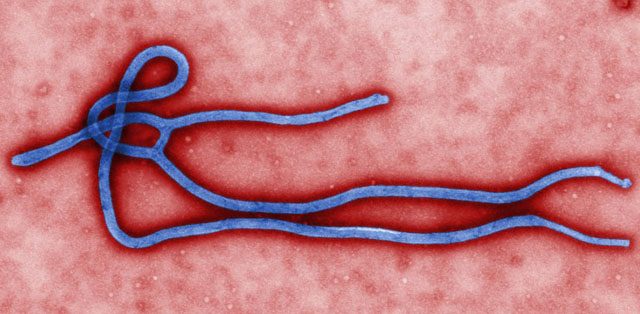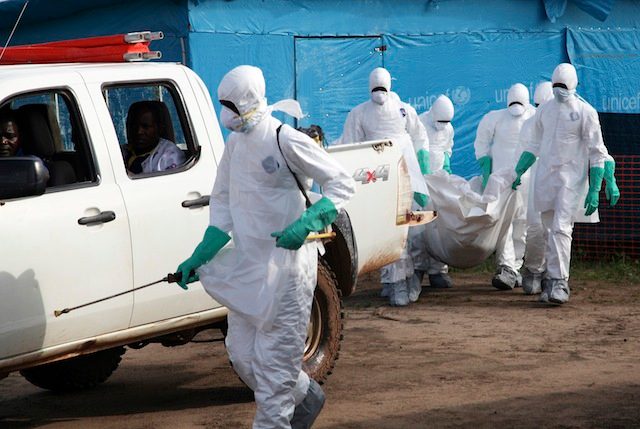SUMMARY
This is AI generated summarization, which may have errors. For context, always refer to the full article.

MANILA, Philippines – As of July 2014, the ongoing Ebola virus epidemic in West Africa holds the record for being the worst outbreak in the recorded history of the virus. The outbreak – which has affected the countries of Guinea, Liberia, and Sierra Leone – now has more than a thousand cases, in which more than half of those are confirmed.
Infections of Ebola virus cause a viral hemorrhagic (bleeding) fever officially known as Ebola hemorrhagic fever or Ebola virus disease, a deadly disease with a fatality rate of up to 90%.
Though more concentrated in parts of Africa, history shows that cases of infection have popped up in other countries as well, particularly here in the Philippines.
Here are few things that you need to know about Ebola virus and the disease that it causes.
1. Ebola outbreaks commonly occur in Central and West Africa.
Ebola was first detected in 1976 during simultaneous outbreaks that occurred in Nzara, Sudan, and Yambuku in the Democratic Republic of Congo. The virus received its name from the Ebola River found in the Democratic Republic of Congo.
In the past 38 years, major outbreaks of the virus happened 6 times in the Democratic Republic of Congo, 3 times in South Sudan, 4 times in Gabon, Uganda, and the Republic of Congo, and once in Cote d’Ivoire and South Africa. The recent 2014 Ebola outbreaks are also in West African countries.
2. Ebola cases have also occurred in countries outside Africa, including the Philippines.
One case of human Ebola virus infection was recorded in the UK in 1976 after a laboratory accident.
In 1989, 1990, and 1996, the virus was detected in primate facilities in the Philippines that exported monkeys all over the globe, leading to 3 cases of viral infection among humans. In the same three years, monkeys exported from said facilities introduced the virus in the USA, causing 4 cases of human infection.
Imported Philippine monkeys also introduced the virus in Sienna, Italy, in 1992.
In 2008 to 2009, the virus was detected once again in the Philippines, this time among domesticated pigs – the first known occurence of the virus among such animals. Six workers in a farm where infected pigs were kept developed antibodies, and did not fall sick.
No fatalities due to Ebola viral infection have been recorded yet outside Africa.
3. As of July, this year’s outbreak is the worst so far (in terms of the number of cases reported).

In contrast, the second worst outbreak, the 2000 outbreak in Uganda, had around 425 cases with 224 deaths.
The first Ebola outbreak in the Democratic Republic of Congo in 1976 had 318 cases and 280 deaths.
4. There are 5 species of Ebola virus.
These species are: Bundibugyo ebolavirus (BDBV), Zaire ebolavirus (EBOV), Reston ebolavirus, (RESTV), Sudan ebolavirus (SUDV), and Tai Forest Ebolavirus. (TAFV)
The World Health Organization (WHO) and the US Centers for Disease Control and Prevention (CDC) state that RESTV has so far caused Ebola Virus Disease only among nonhuman primates (i.e. chimpanzees, gorillas) and pigs.
The rest are known to have caused diseases in human beings. In fact, BDBV, EBOV, and SUDV are the culprits behind large Ebola outbreaks.
5. Ebola infects humans through close contact with the bodily fluids & secretions of infected animals or humans.
According to the WHO, fruit bats are the most common hosts of the virus. Other animals commonly infected with the virus are nonhuman primates, monkeys, forest antelopes, and porcupines. It is theorized that large Ebola outbreaks occur often in West and Central Africa due to the locals’ practice of hunting and eating meat from wild animals often infected with the virus
People can also be indirectly infected via exposure to objects or areas that have been contaminated with the bodily fluids of the infected, like used syringe needles or improperly sterilized medical instruments used during an outbreak.
Even those who have recovered from Ebola Virus Disease can still transmit the virus. According to the WHO, there have been cases where men who have recovered from the disease can still transmit the virus through their semen for up to seven weeks.
6. There’s no cure yet to combat Ebola Virus Disease.
There are no licensed cures, vaccines or treatments yet to directly combat Ebola Virus Disease. In the history of the virus’ outbreaks, the disease kills around 25% to 90% of the total number of infected individuals.
Diagnosis of the virus via its symptoms is difficult as as they are similar to symptoms of malaria, typhoid fever, shigellosis, cholera, and other viral hemorrhagic fevers.
Timely treatment of Ebola is challenging due to the difficulty in diagnosing the early stages of infection. The WHO states that several laboratory tests are needed to diagnose Ebola infections definitively and that acquiring samples for these tests is extremely hazardous and should be conducted under maximum biohazard containment conditions.
According to the CDC and the WHO, isolation and quarantine of infected individuals, intensive care and supportive therapy, maintaining the balance of the patient’s fluids and electrolytes, and treatment of any complicating infections remain the standard treatment for mitigating the effects of the disease
7. Persons at the highest risk during Ebola virus outbreaks: family and friends of infected individuals and health care workers.
As they are involved in everyday close interactions with infected or possibly infected individuals, the family and friends of infected persons are likely to be at a high risk during outbreaks if not infected already.

Health care workers treating patients during outbreaks, or handling samples taken from the infected during studies, investigations, and researches into the disease, are also at high risk of being infected and falling ill themselves. During the recent 2014 outbreaks, Dr. Omar Khan, who was in charge of the main Ebola treatment in Kenema, Sierra Leone, was infected with the virus and died of disease.
8. Prevention of Ebola Virus Disease outbreaks is difficult as it is hard to assess the risk of Ebola virus infections until disease actually breaks out.
However, since the virus is carried by animals first, the WHO advises facilities that work with animals like farms or zoos to have routine and thorough cleaning and disinfection. If outbreaks occur, then the area must be placed in quarantine and infected animals must be isolated and/or culled under the supervision of health authorities.
Animal products, especially the meat and blood of Ebola-infection prone animals, should be cooked thoroughly. It is also advisable to avoid taking meat from animals found dead or from animals that are sick or behaving oddly.
As for human to human contact, the CDC listed down countries known to have had large Ebola outbreaks and warned people travelling to said countries to take extra health precautions during their visit. If outbreaks do occur, it is advisable to avoid going to affected countries altogether.

-Rappler.com
Sources: World Health Organization: Ebola Virus Disease, WHO Global Alert and Response: Ebola Reston In Pigs and Humans, Center for Disease Control and Prevention: Ebola, CDC: Ebola: Known Outbreaks and Cases, CDC Ebola Fact Sheet, CDC Interim Guidance About Ebola Virus Infection for US Citizens Living Abroad, CDC Outbreak of Ebola in Guinea, Liberia, and Sierra Leone, Food and Agriculture Organization of the UN: Fruit Bat Warning, Mayo Clinic: Ebola Virus Disease Prevention, Oxford Journal of Infectious Diseases: Ebola Reston Virus Infection of Pigs, Clinical, Significance and Transmission Potential.
See related stories:
- Ebola death toll rises to 887 – WHO
- First Ebola case on US soil as doctor returns home
- Ebola outbreak speeds up efforts to find a vaccine
- Ebola ‘moving faster than efforts to control it’: WHO
- Ona: Philippines ready for Ebola
- DOH Monitoring 7 OFW’s from Ebola-hit Sierra Leone
- More articles on the ongoing ebola outbreak
Add a comment
How does this make you feel?
There are no comments yet. Add your comment to start the conversation.